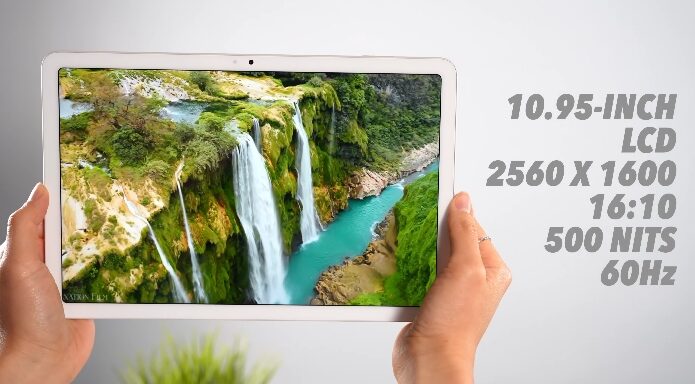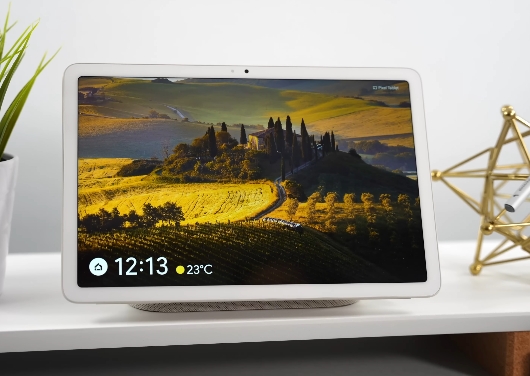The Pixel tablet is an Android-powered device that serves as both a tablet and a smart display. When connected to the included charging speaker dock, it transforms into a smart multimedia display with integrated speakers. If it were solely marketed as a $500 Android tablet its success might be limited, given strong competition from iPads. However, by offering a unique combination of tablet functionality and smart display features Google Pixel Tablet aims to stand out.
Design and Aesthetics

The Google’s Pixel tablet makes more sense than the $450 entry-level iPad. The white bezels on this porcelain model might be controversial, as black bezels are the norm nowadays. Personally, I like it and think it looks good in the right home setting. The Pixel Tablet backside has a nano coating on the aluminum build, giving it a nice feel and a distinct Google aesthetic, and the finish also prevents fingerprints, which is great. The fingerprint scanner is embedded in the power button and works 100% of the time, It’s the only biometric option; there’s no face unlock.
Display Picture Quality

The Pixel tablet features a 2560 by 1600 LCD display, some may be disappointed that it’s not OLED, but it’s worth noting that this tablet also functions as a smart display. Constantly using an OLED display could result in burn-in issues. The 16 by 10 aspect ratio aligns with Google’s vision of this device as primarily a multimedia tool. The only aspect that feels somewhat disappointing to me is the 60Hz refresh rate. I would have preferred a 90Hz refresh rate, as 60Hz may seem a bit outdated in 2023, especially for a touchscreen tablet.
Stylus and Keyboard

Google didn’t heavily market this as a note-taking or drawing tablet, but it supports USI 2.0 stylus pens. I got one from Knovel, and while it’s not as responsive as the Apple Pencil or S Pen, it gets the job done. The pen has magnets to attach to the tablet, and it makes me think Google might launch their own stylus. It attaches to the top too, which is pretty good.
Even though Google didn’t release it with a keyboard attachment, Android works well with a Bluetooth keyboard. It’s easy to pair, making word processing, answering emails, or messaging a much better experience.
Processor and Performance

The Pixel tablet is equipped with 8 gigabytes of RAM and offers storage options of 128 or 256 gigabytes. It runs on the Tensor G2 chip, the same processor found in the current Pixel phones, including the flagship Pixel 7 Pro, indicating a similar performance. Although benchmarking slightly lower in my experience, it’s essential to note that my unit is running pre-release software, which could explain the variance. Nevertheless, the overall performance has been smooth with no stutters or lag. It’s more than capable for casual gaming, but for more demanding games like Genshin Impact, expect optimal performance on low to medium graphic settings.
Software and UI

The software experience on the Pixel tablet is familiar for Pixel phone owners. The home screen has the At a Glance widget and a Google search bar in the dock, accommodating six favorite apps. Multitasking allows running two apps side by side with adjustable sizes, but there’s no desktop mode like Samsung DeX or Apple Stage Manager; Google keeps it simple.
The tablet supports multiple users, crucial for a shared family hub. Each profile has separate apps and content, with up to eight profiles available, including a child account for app restrictions and screen time limits.
Pre-loaded with popular Google apps, optimized for the larger screen, Android on tablets is a work in progress, but the list of optimized apps is growing. Unoptimized apps slide to the sides when double-tapped, useful for landscape holding. If this bothers you, rotating the tablet turns it into a large phone.
Android tablets have been criticized for lacking pro-level apps, and the Pixel tablet doesn’t change that. Not marketed toward creatives or professionals, it’s designed for casual tablet use around the house, not as a laptop replacement.
Charging Dock with Built-in Speaker

The standout feature of the Pixel tablet is its charging speaker dock. While the magnets are strong, there were instances when adjusting the volume caused the tablet to knock off the dock, especially with the kickstand case. It’s not a significant issue, but caution is advised, particularly if you have kids who might handle things more forcefully.
As the tablet charges continuously when docked, concerns about battery health arose. To address this, Google limits the maximum charge to 90%. You can override this in battery settings, but it resets every time you redock the tablet. For a full 100% charge, you need to use a USB-C cable, keeping in mind that the tablet doesn’t include a charger, except for the dock.
Audio, Hub Mode and Built-In Chrome Cast
The audio handoff between the dock and tablet is excellent. It’s satisfying to listen or watch content on the tablet and then place it on the dock for an immediate improvement in the audio experience. The transition is smooth, and the audio from the dock sounds better than the quad speakers on the tablet itself. With added bass, it effectively fills a mid-sized room. Notably, the sound doesn’t come from all directions despite the design; it all comes from the front, providing the best audio experience when standing in front of it.

When docked, locking the tablet activates Hub mode. Pressing the power button a second time turns the display completely off. I was originally looking for a digital photo frame, and this serves that purpose perfectly. It’s great to have memories from my phone displayed randomly throughout the day, adding a nice human touch to technology.
You can control your smart devices by tapping the Google Home icon. Setting up was straightforward; signing into my Google account brought all my smart home devices immediately. Using voice commands, you can control connected devices, ask questions, set timers, and more. Thanks to Google Assistant, voice pickup works surprisingly well, even from another room. If privacy concerns you, Google provides an option to block microphone and camera access when not needed.
The Pixel tablet is the first to integrate Chromecast. If you haven’t used Chromecast, it allows you to cast content from your phone directly to the tablet. For example, if I’m watching a YouTube video on my phone, I simply look for the Cast icon, select the Pixel tablet, and the video starts playing on the tablet.
Battery life and Extra Dock?

Regarding Google Pixel Tablet battery life, I couldn’t achieve the claimed 12 hours that Google promises for video streaming. Watching a 4K YouTube video at approximately 70% brightness consumed 14% of the battery, translating to just over seven hours. Adjusting the brightness lower will undoubtedly extend battery life. With mixed usage, I estimate around seven to eight hours. However, because it’s convenient to dock and charge the tablet, I haven’t been overly concerned about the battery life.
Additional docks are available for purchase to place around the house, but since the dock doesn’t provide any functionality without the tablet attached, it doesn’t seem worthwhile to me. Enhancements to the dock could have made it more useful independently, such as incorporating it as a standalone Bluetooth speaker with Google Assistant. I also wish it had a tilt function, as the fixed angle might not be ideal depending on its placement. While the dock is a cool idea, I wouldn’t be surprised to see Apple or Samsung explore something similar.
Final Thought
Similar to many first-generation products, there’s room for improvement, but credit goes to Google for finding a clever way to create a tablet with enhanced functionality in our homes. It serves as a versatile smart home hub, a digital picture frame, and a dedicated multimedia device for the entire family. The inclusion of the dock in the box makes it more appealing compared to if it were just a standalone Android tablet.
Android on tablets is far from perfect, but if you don't care for pro-level apps and just want a multimedia device with simple software that everyone in the family can use, google pixel tablet, as usual.
-
Design8
-
Display7
-
Stylus and Keyboard6
-
Performance8
-
Software and UI7
-
Charging Dock9
-
Battery Life7
